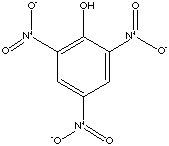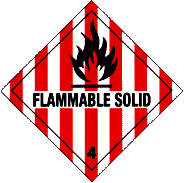Picric acid
- Picronitric acid
- 2,4,6-Trinitrophenol

Picric acid | |
| |
| Formula | C6H3N3O7 |
| Structure |  |
| Description | Can be detonated with a number 8 electric blasting cap. |
| Uses | Medication (vet). |
| Registry Numbers and Inventories. | |
| CAS | 88-89-1 |
| EC (EINECS/ELINCS) | 201-865-9 |
| EC Index Number | 609-009-00-X |
| EC Class | Explosive; Forms very sensitive explosive metallic compounds; Toxic |
| RTECS | TJ7875000 |
| RTECS class | Mutagen |
| UN (DOT) | 1344 |
| Merck | 12,7562 |
| Beilstein/Gmelin | 423400 |
| Beilstein Reference | 4-16-00-00984 |
| Swiss Giftliste 1 | G-2754 |
| Canada DSL/NDSL | DSL |
| US TSCA | Listed |
| Austrailia AICS | Listed |
| New Zealand | Listed |
| Japan ENCS (MITI) | Listed |
| Korea ECL | Listed |
| Properties. | |
| Formula | C6H3N3O7 |
| Formula mass | 229.11 |
| Melting point, °C | 122-123 |
| Boiling point, °C | 255 |
| Vapor pressure, mmHg | 0.00364 (100 C) |
| Vapor density (air=1) | 7.9 |
| Density | 1.763 g/cm3 |
| Solubility in water | 1.4 g/100 ml |
| Viscosity | 12 cp (125 C) |
| Refractive index | 1.763 (20 C) |
| pKa/pKb | 0.35 (pKa) |
| Partition coefficient, pKow | 1.33 |
| Heat of vaporization | 87.92 kJ/mol |
| Heat of combustion | -2589 kJ/mol |
| Hazards and Protection. | |
| Storage | Keep away from heat, sparks, and flame. Keep container closed to prevent drying out. Keep away from metals. Material can explode if dry. Do not store on concrete. |
| Handling | Wash thoroughly after handling. Use only in a well ventilated area. Minimize dust generation and accumulation. Material is heat, shock and/or friction sensitive. Use care in handling and storage. Loosen closure cautiously before opening. Avoid contact with skin and eyes. Avoid contact with heat, sparks and flame. Container should be opened by a technically qualified person. Avoid mechanical shock and friction. |
| Protection | Eyes: Wear appropriate protective eyeglasses or chemical safety goggles as described by OSHA's eye and face protection regulations in 29 CFR 1910.133 or European Standard EN166. Skin: Wear appropriate protective gloves to prevent skin exposure. Clothing: Wear appropriate protective clothing to prevent skin exposure. |
| Respirators | Follow the OSHA respirator regulations found in 29CFR 1910.134 or European Standard EN 149. Always use a NIOSH or European Standard EN 149 approved respirator when necessary. |
| Small spills/leaks | Remove all sources of ignition. Carefully scoop up and place into appropriate disposal container. If the material is dry, explosives experts may be necessary to dispose of the spill. Isolate area and deny entry. Wet area to prevent drying out. Provide ventilation. |
| Stability | Substance is shock sensitive and thermally unstable. |
| Incompatibilities | Metals; strong bases; ammonia; strong reducing agents; strong oxidizing agents; concrete; plaster; |
| Decomposition | Carbon monoxide, oxides of nitrogen, carbon dioxide. |
| Fire. | ||||
| Flash Point,°C | 150 | |||
| Autoignition, °C | 300 | |||
| Fire fighting | Dangerously explosive. Do not fight fires in a cargo of explosives. Evacuate area and let burn. | |||
| Fire potential | Flammable/combustible material. | |||
| Hazards | May be ignited by heat, sparks or flames. DRIED OUT material may explode if exposed to heat, flame, friction or shock; Treat as an explosive. Keep material wet with water or treat as an explosive. Runoff to sewer may create fire or explosion hazard. MAY EXPLODE AND THROW FRAGMENTS 1600 meters (1 MILE) OR MORE IF FIRE REACHES CARGO. | |||
| Combustion products | Fire may produce irritating, corrosive and/or toxic gases. | |||
| NFPA | Health | 3 | ||
| Flammability | 4 | |||
| Reactivity | 4 | |||
| Health. | |
| Exposure limit(s) | OSHA PEL: TWA 0.1 mg/m3 skin NIOSH REL: TWA 0.1 mg/m3 ST 0.3 mg/m3 skin NIOSH IDLH: 75 mg/m3 |
| Poison_Class | 2 |
| Exposure effects | Prolonged or repeated eye contact may cause conjunctivitis. Prolonged or repeated skin contact may cause sensitization dermatitis and possible destruction and/or ulceration. Prolonged or repeated exposure may cause yellow staining of the skin and conjunctiva and yellow vision. |
| Ingestion | Harmful if swallowed. May cause gastrointestinal irritation with nausea, vomiting and diarrhea. May cause kidney damage. May cause headache. May cause tremors and convulsions. May cause unconsciousness. May cause acute hepatitis. |
| Inhalation | May cause respiratory tract irritation. May cause effects similar to those described for ingestion. May cause kidney damage. |
| Skin | Causes skin irritation. If absorbed, causes symptoms similar to those of ingestion. May cause dermatitis. |
| Eyes | Causes eye irritation. May result in corneal injury. |
First aid |
|
| Ingestion | If victim is conscious and alert, give 2-4 cupfuls of milk or water. Never give anything by mouth to an unconscious person. Get medical aid. Induce vomiting by giving one teaspoon of Syrup of Ipecac. |
| Inhalation | Remove from exposure to fresh air immediately. If not breathing, give artificial respiration. If breathing is difficult, give oxygen. Get medical aid. |
| Skin | Get medical aid immediately. Flush skin with plenty of soap and water for at least 15 minutes while removing contaminated clothing and shoes. Wash clothing before reuse. |
| Eyes | Immediately flush eyes with plenty of water for at least 15 minutes, occasionally lifting the upper and lower eyelids. Get medical aid immediately. |
| Transport. | ||
| UN number | 1344 |  |
| Response guide | 113 | |
| Hazard class | 4.1 | |
| Packing Group | I | |
| USCG CHRIS Code | PRI | |
| Std. Transport # | 4901510 | |